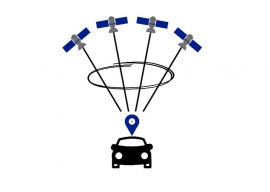Final Presentation of NAVISP EL1-066: “GOOSE-VTL: Deeply Coupled GNSS Vector Tracking Loop for Robust Autonomous-Vehicle Navigation”
Last Updated: 21/05/2025 08:11 Created at: 21/05/2025 08:11

On Tuesday, 13 May 2025, TeleOrbit GmbH, Fraunhofer IIS and the Bundeswehr University Munich delivered the final results of the NAVISP EL1-066 project. GOOSE-VTL set out to harden GNSS positioning in dense urban environments by replacing conventional scalar tracking with deeply-coupled vector tracking (VT) and INS-aided deep coupling (DC) inside the GOOSE software-defined receiver.
Key achievements of the project were:
- End-to-end architecture realised
GOOSE v2 hardware-accelerated SDR hosts new VT and DC tracking loops, a real-time PVT engine, and a multipath/quality monitor (SQM) that flags distorted signals. - Robust performance proven in simulation
Spirent-based urban-canyon scenarios showed VT maintaining continuous tracking where scalar loops lost signal lock. - Field validation of deep coupling
Ten-minute drive tests on the UniBw Munich campus confirmed that DC-aided GOOSE out-performed standalone GNSS.
GOOSE-VTL demonstrates that deeply-coupled vector tracking in an open SDR platform can deliver the resilience and accuracy that next-generation autonomous systems need in GNSS-challenged urban settings.
This project was funded by NAVISP Element 1 which focuses on technology push in the PNT domain.
The slides can be accessed here.
